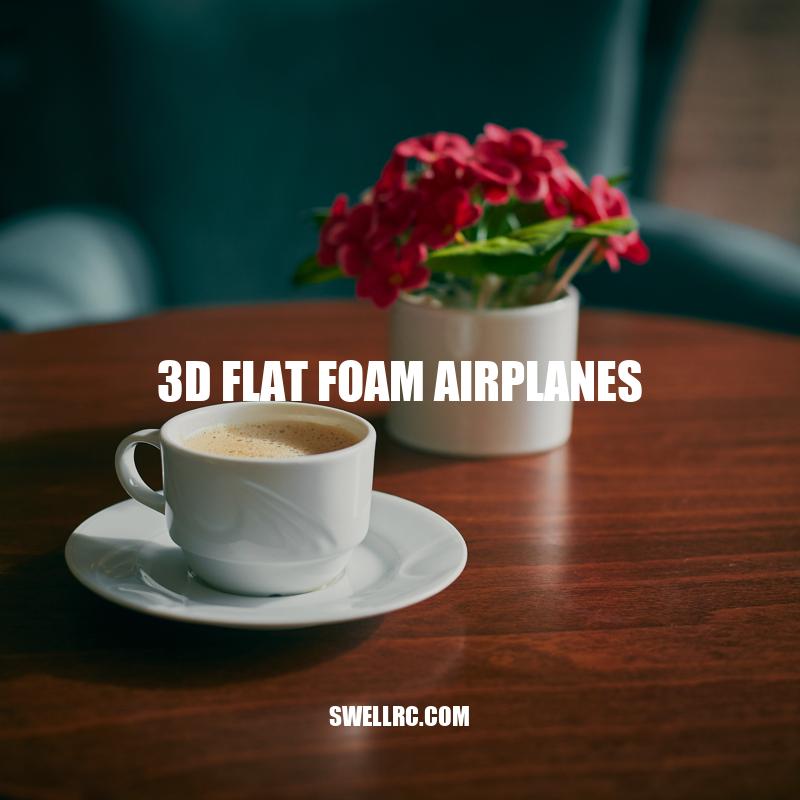Ultimate Guide to 3D Flat Foam Airplanes
Foam airplanes have become increasingly popular over the years, with 3D flat foam airplanes being a common choice for beginners and hobbyists. Foam, as a material for building airplanes, has several advantages over other materials such as balsa wood and fiberglass. It is light in weight, making it easy to handle, and can be easily repaired in case of damage. Additionally, foam is relatively cheaper compared to other materials, making it a more affordable option for anyone who wants to take part in the exciting world of model airplanes. The 3D design of the airplanes allows for better flight control, giving the hobbyist more maneuverability. In this article, we will highlight the benefits of 3D flat foam airplanes and guide you on how to build, fly, and maintain them. We will also provide recommendations on some of the best 3D flat foam airplane models in the market to help you choose the right one for you.
The Advantages of 3D Flat Foam Airplanes
There are several advantages to choosing 3D flat foam airplanes as your model of choice:
- Lightweight material makes it easier to handle, launch and land the airplane, especially for beginners
- Can be easily repaired in case of damage – a common occurrence for new hobbyists
- Lower cost compared to other materials such as balsa wood and fiberglass
- Allow for 3D design, which results in better flight control and more maneuverability
- Can fly at slower speeds, making it ideal for indoor flying and small outdoor spaces
- Some models come with pre-cut foam pieces, making it easier to build, especially for beginners
If you’re interested in browsing for 3D flat foam airplane models, some of the best-reviewed models include the following:
| Model | Features | Price* |
|---|---|---|
| HobbyZone Delta Ray | Lightweight, intuitive control, SAFE technology | $199.99 |
| Tower Hobbies Vista EP RTF | Easy-to-assemble, lightweight, durable | $129.99 |
| Flite Test Mighty Mini Tiny Trainer | Pre-cut foam pieces, beginner-friendly, high maneuverability | $39.99 |
* Prices may vary based on location and time of purchase.
What foam is best for model airplane?
There are different types of foam that can be used for model airplanes. The best foam for your model airplane will depend on several factors such as your budget, the design of your plane, and your preference. Here are some common types of foam that are used for model airplanes:
- Expanded Polystyrene (EPS): This is the most common material used for foam model airplanes. It is lightweight, affordable, and easy to work with. However, EPS foam is not very strong and can break easily.
- Extruded Polystyrene (XPS): XPS foam is stronger and more durable than EPS foam. It is also more expensive. XPS foam is often used for larger model airplanes or planes with more complex designs.
- Polyurethane Foam (PU): This is a dense and tough foam that is ideal for high-performance model airplanes. PU foam is more expensive than EPS or XPS foam but offers superior strength and durability.
- Depron Foam: This is a brand of foam that is specifically designed for model airplanes. It is lightweight, strong, and easy to shape. Depron foam is more expensive than EPS foam but offers better performance.
You can find different types of foam for your model airplane in most online hobby shops or craft stores. Before purchasing, make sure to study your plane’s design and the foam specifications to choose the best foam for your model airplane.
Building Process of 3D Flat Foam Airplanes
Before building a 3D flat foam airplane, it’s important to have a plan and design in mind. Here are the steps to follow in order to build your own 3D flat foam airplane:
- Select the model or design you want to build
- Gather all necessary materials, including foam insulation boards, sharp utility knife, electrical wire, glue, and motor mount
- Use the design or plan to create a template on a piece of foam insulation board
- Cut out the foam pieces using a sharp utility knife or laser cutter
- Assemble the foam pieces together using glue
- Install the electrical wire and motor mount
- Add any additional details or decorations as desired
Interesting fact: Did you know that 3D flat foam airplanes have been gaining popularity among hobbyists and enthusiasts in recent years due to the lightweight and affordable nature of the material?
If you’re new to building model airplanes, you may want to check out some online tutorials and resources to help you get started. Some popular websites that offer tutorials and resources include FliteTest.com and RCGroups.com.
Here’s a list of the materials you may need to build your 3D flat foam airplane:
| Materials | Description |
|---|---|
| Foam Insulation Board | A lightweight material that is easy to work with and affordable |
| Sharp Utility Knife | The ideal tool for cutting foam insulation board |
| Electrical Wire | To connect the motor and battery |
| Glue | To assemble the foam pieces together |
| Motor Mount | To install the motor onto the airplane |
How do you fix a foam airplane?
To fix a foam airplane, you can follow these steps:
- Identify the damaged area of the foam airplane.
- Use foam-safe glue to apply a thin layer of glue to both sides of the damaged area.
- Press the two sides together and hold them in place until the glue dries.
- If the damage is more severe, you may need to use tape or even replace the damaged foam piece.
Some products that can be helpful when fixing a foam airplane include:
| Product | Description |
|---|---|
| Foam-safety glue | A specialized type of glue that is safe for use on foam and will not dissolve or damage the foam material. |
| Foam repair kit | A kit containing various materials needed to repair foam products, including glue, tape, and replacement foam pieces. |
There are also many helpful videos and tutorials online that can provide step-by-step guidance on repairing a foam airplane.
Flying a 3D flat foam airplane can be a thrilling experience, but it’s important to take necessary precautions and follow some basic guidelines. Here are some tips to help you get started:
Make sure the airplane is properly balanced before flying
Check the weather forecast and choose a calm and clear day for flying
Choose a large open area to fly the airplane
Practice basic controls such as takeoff, throttle, and landing before attempting any aerobatic maneuvers
Never fly the airplane near people or buildings
Always keep your eyes on the airplane while flying
Be mindful of the battery life and landing time of the airplane to avoid crash landings
Interesting fact: Did you know that 3D flat foam airplanes are versatile and can perform aerobatic maneuvers such as rolls, loops, and inverted flight?
If you’re new to flying RC planes, it’s important to take the time to learn and practice basic skills. There are many online resources available that offer tutorials, tips, and advice on flying RC planes. Some popular websites that offer tutorials and resources include RCGroups.com and FliteTest.com.
Here’s a list of some essential items you may need for flying your 3D flat foam airplane:
Transmitter and Receiver – to control the airplane
LiPo Battery and Charger – to power the airplane
Propeller – to help the airplane move forward
Controller Batteries – to power the transmitter and receiver
Charging Bag – to protect and charge the LiPo battery
Are foam RC planes durable?
Foam RC planes can be quite durable depending on the quality of the foam used and the overall construction of the plane. In general, foam planes tend to be more resilient to crashes and damage compared to their wooden or metal counterparts. However, it’s important to note that foam planes can still break or tear if they experience a hard impact. Here are some things to consider:
– Look for planes made from high-quality foam, like expanded polypropylene (EPP) or expanded polystyrene (EPS), which are both known for their durability and ability to withstand crashes.
– Check the construction of the plane – if it includes reinforcements like carbon fiber, this can help increase its durability.
– Proper maintenance and care can also help extend the life of your foam plane. Keep it clean, dry, and stored in a safe place when not in use.
There are many websites and products available for foam RC planes, so be sure to do your research before making a purchase. Some popular options include:
– Horizon Hobby (https://www.horizonhobby.com/category/airplanes/airplanes-14501–1/ready-to-fly-rc-airplanes/foam-and-epo-airplanes)
– Flite Test (https://www.flitetest.com/articles/top-5-best-foam-rc-planes)
– Motion RC (https://www.motionrc.com/collections/foam-rc-airplanes)
Maintenance and Repair of 3D Flat Foam Airplanes
Proper maintenance and regular inspection are important to keep your 3D flat foam airplane in good condition. Here are some tips to help you with maintenance and repair:
- After every flight, inspect the airplane for any damage or wear and tear
- Replace any damaged or worn out parts before flying again
- Store the airplane in a clean and dry area when not in use
- Keep the motor and battery clean and free of debris
- If the airplane is in storage for a long time, remove the battery and store it separately
- Practice safe battery charging and storage practices to avoid any accidents
- If you’re unsure of any repairs or maintenance, seek professional help
It’s important to invest in quality parts and accessories for your 3D flat foam airplane. Some popular online stores that offer parts, accessories, and upgrades for RC planes include HobbyKing, Banggood, and Motion RC.
If you’re looking for a reliable and durable 3D flat foam airplane, some popular models to consider include:
| Model | Description |
|---|---|
| FMS Extra 300 | A versatile and aerobatic airplane that’s easy to control |
| E-flite UMX Pitts S-1S | A small and lightweight airplane that can perform a range of maneuvers |
| Flex Innovations Mamba 60E | A larger airplane with a powerful motor that can perform 3D maneuvers |
These models are great for beginners and advanced RC airplane enthusiasts alike. Be sure to check the specifications and user reviews before making a purchase.
What kind of foam is used for model airplanes?
The most commonly used foam for model airplanes is Expanded Polystyrene (EPS) foam. EPS foam is lightweight, easy to work with, and provides a good balance between strength and flexibility. Other foam types used for model airplanes include Extruded Polystyrene (XPS) foam, Depron foam, and EPP foam. It’s important to choose the right foam depending on the type of plane you’re building. EPS foam can easily be sourced from hardware and home improvement stores or from online retailers like Amazon and Home Depot. Similarly, Depron foam and EPP foam can be purchased from hobby shops or online retailers like MotionRC and RCgroups.com.
| Foam Type | Properties |
|---|---|
| EPS foam | – Lightweight – Good balance between strength and flexibility – Easy to work with |
| XPS foam | – More rigid and dense than EPS – More difficult to work with – Better suited for intricate designs |
| Depron foam | – Lightweight and rigid – More fragile than EPS and XPS foam – Ideal for small planes and indoor models |
| EPP foam | – Highly flexible and durable – Resistant to impact and damage – Good for planes designed for rough landings and crashes |
Recommended 3D Flat Foam Airplane Models
There are various 3D flat foam airplane models available in the market, but some stand out from the rest in terms of performance, durability, and overall value. Here are some of the recommended 3D flat foam airplane models to consider:
- FMS Extra 300: This is a versatile airplane that can perform various 3D maneuvers, including knife-edge, loops, and rolls. With its powerful brushless motor, large control surfaces, and lightweight foam construction, the FMS Extra 300 is an excellent choice for intermediate and advanced pilots.
- E-flite UMX Pitts S-1S: This miniature airplane is perfect for indoor and outdoor flying. With its lightweight and durable foam construction, it can withstand small crashes and is easy to transport. The E-flite UMX Pitts S-1S can perform loops, rolls, and inverted flights, making it an excellent option for beginners and experienced pilots alike.
- Flex Innovations Mamba 60E: This larger airplane is perfect for intermediate and advanced pilots. With its brushless motor, large control surfaces, and lightweight construction, the Flex Innovations Mamba 60E can perform high-speed passes, high-alpha flight, and various 3D maneuvers. This airplane delivers excellent value for its price and is highly recommended for pilots who want to take their flying skills to the next level.
You can find these models and other 3D flat foam airplane models on various online stores such as Horizon Hobby, 3D Hobby Shop, and Flite Test. When choosing a model, consider your flying experience, budget, and personal preferences. Do some research on the specifications, user reviews, and videos before you make a purchase.
What are the different types of RC plane foam?
There are several types of foam that are commonly used for RC planes, each with its own strengths and weaknesses. Some of the most popular types are:
- Expanded Polypropylene (EPP) – This is a durable, flexible foam that is ideal for building planes that can withstand crashes and impacts. Some popular EPP foam options include the Flite Test Versa and the Twisted Hobbys Crack Yak.
- Expanded Polystyrene (EPS) – EPS foam is lightweight and inexpensive, making it a great option for beginners or for planes that don’t require a lot of strength or rigidity. The Flite Test Tiny Trainer is a popular EPS foam RC plane.
- Extruded Polystyrene (XPS) – XPS foam is denser and more rigid than EPS, but also more brittle. It’s a good choice for planes that need to be very sturdy, like acrobatic or racing planes. The Ritewing Mini Drak is made from XPS foam.
There are also some specialty foams available, like Depron and Fan Fold Foam, that are popular with hobbyists. It’s important to choose the right foam for your particular project, based on factors like strength, weight, and flexibility. Websites like FliteTest and Motion RC offer a variety of RC plane foam options and resources for builders to learn more about choosing the right foam.
Conclusion
Building and flying 3D flat foam airplanes is a fun and rewarding hobby that can be enjoyed by people of all ages and skill levels. The lightweight foam material, lower cost, and easy repair make these airplanes an excellent option for beginners and hobbyists who want to learn the basics of aeromodelling without breaking the bank.
Whether you want to fly indoors or outdoors, perform high-speed passes or 3D maneuvers, there is a 3D flat foam airplane model that will suit your needs. The key is to choose the right model for your experience level and flying style, and to follow the instructions carefully when building and flying the airplane.
Practice and persistence are essential to develop your flying skills and become a better pilot. Take advantage of the many online resources available, including forums, videos, and tutorials, to learn from experienced pilots and to get advice on how to improve your technique.
3D flat foam airplanes offer endless possibilities for creativity and enjoyment. With a little patience, dedication, and practice, you can take your passion for flying to new heights.



